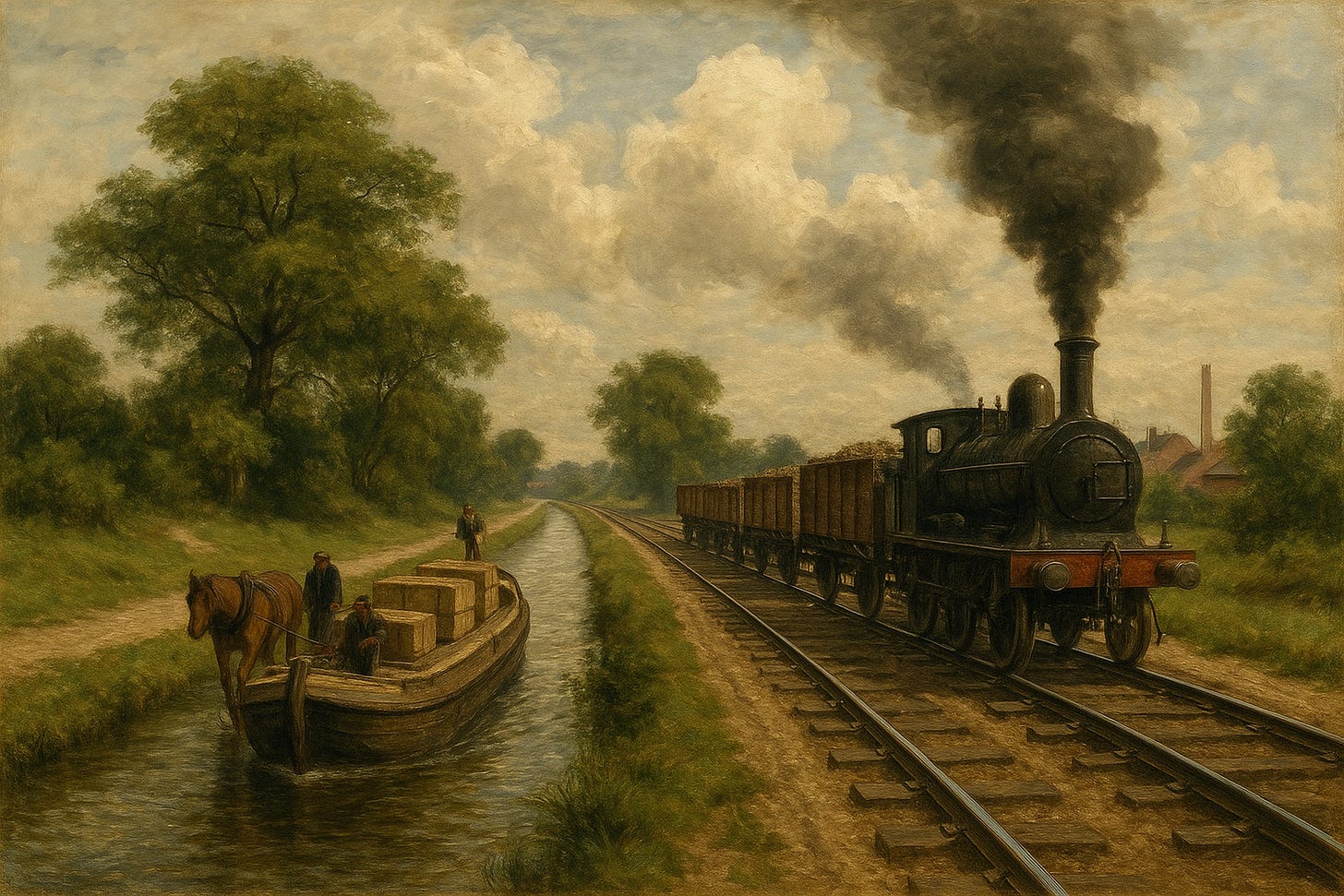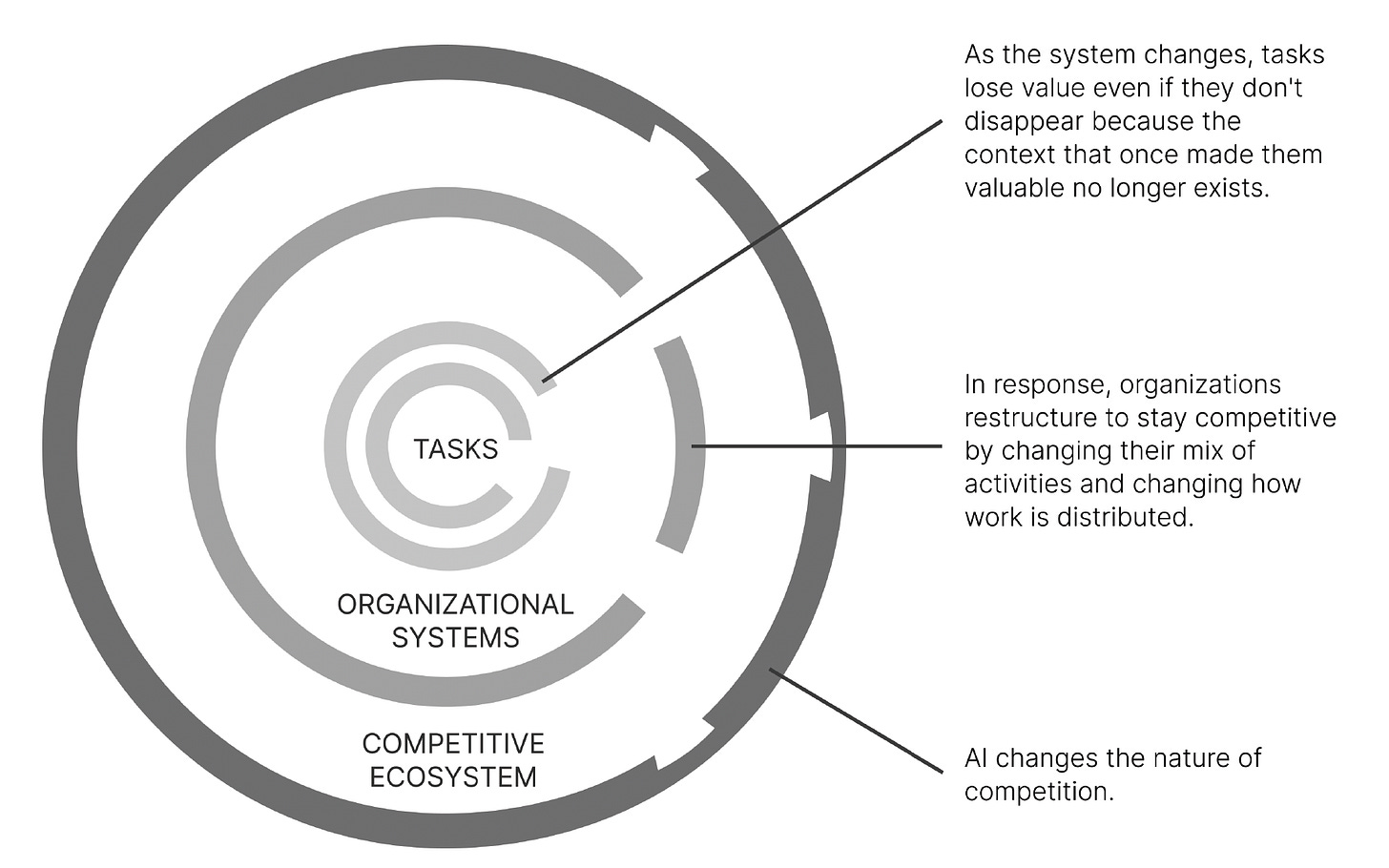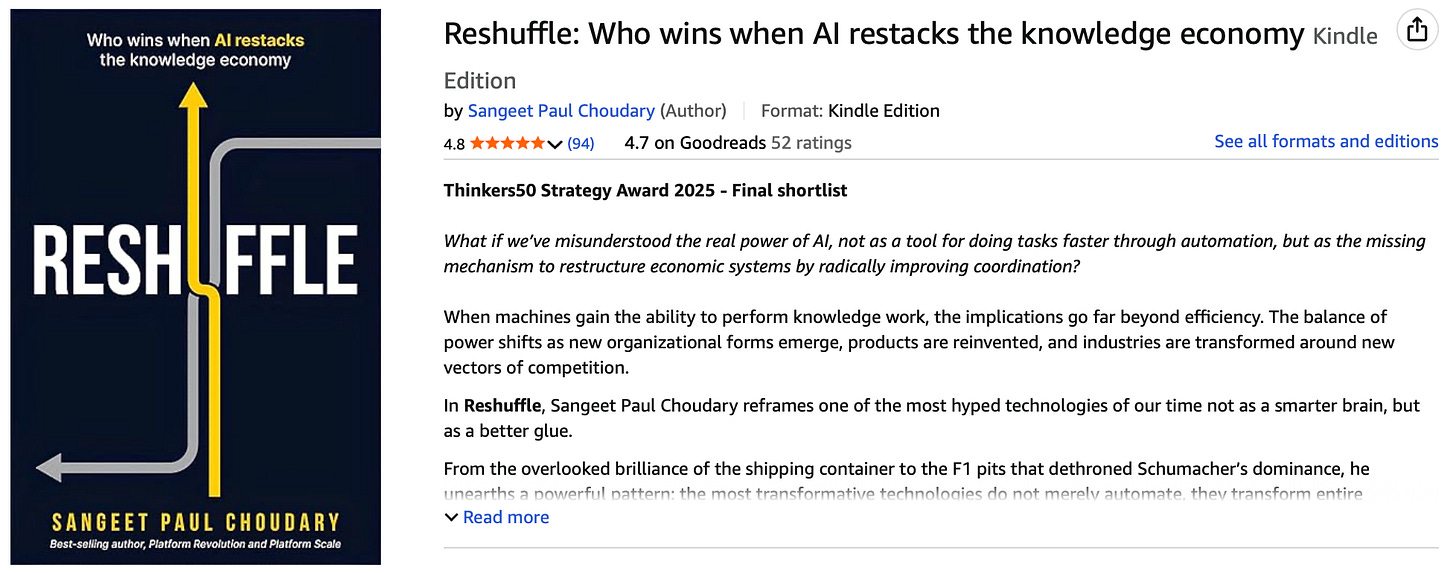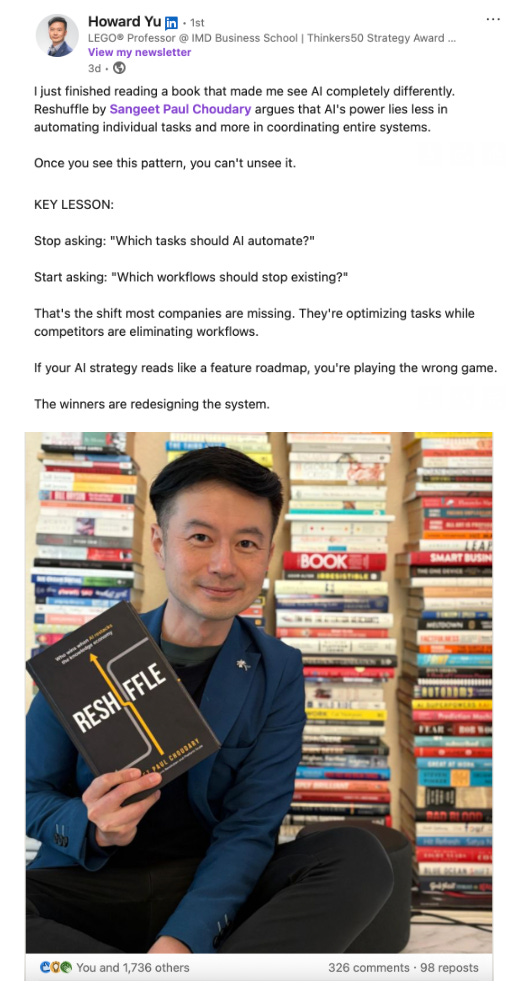The problem with agentic AI in 2025
Too much automation can blind you to the real opportunity
In the early nineteenth century, canals represented the height of industrial progress. They connected inland towns with ports, allowing coal, grain, and other bulk goods to move at far lower cost than by wagon.
For a time, canals delivered exactly what they promised: lower transportation costs and smoother flows of commerce.
Railroads, when they appeared, seemed at first like a faster version of the same idea. Yet their impact was of an entirely different order.
Like canals, railroads reduced the cost of moving goods. Far more importantly, though, they changed the entire logic of commerce.
Trains ran on fixed timetables, and as railway lines stretched across hundreds of miles, local timekeeping started to become a problem. Before railroads, every town set its clocks by the sun, which meant noon in one town could be fifteen minutes different from noon in the next. That was tolerable for canals, where barges moved slowly and deliveries were measured in days or weeks. But it made railroads unworkable.
Faster railroads resulted in a coordination failure.
To coordinate trains safely across long distances, the industry had to impose standardized time zones.
That act of forcing distant towns and cities to operate on the same clock had far-reaching economic consequences.
It meant grain in Chicago could be priced against demand in New York on the same schedule.
It allowed financial markets, shipping companies, and manufacturers to plan production and deliveries with a new degree of precision.
Canals lowered the cost of moving a barrel of flour from one city to another. But Railroads created a world where supply and demand could be matched across vast regions in real time, because the movements of goods and information could now be coordinated on a shared clock.
Canals and railroads seem similar - they are both transportation technologies. Yet, they require fundamentally different mindsets.
Canal engineers thought like cost optimizers: How do you cut the time or expense of moving goods along an existing path?
Railroad builders were forced to think like system designers: How do you align schedules, enforce standardized time-zones, and orchestrate the movements of thousands of passengers and shipments across a continent?
The railroad’s significance lay in coordination.
Those who clung to the mindset of canals missed the real value of railroads. They saw a faster way to move coal and cotton, but couldn’t have imagined the invention of national markets.
This is the classic trap when a new technology resembles the old. We instinctively draw on the mental models of the last breakthrough. The trouble is that those models smuggle in assumptions that limit the possibilities that the new tech offers.
Canal logic never yielded time zones. Only when people realized the railroad demanded that clocks in Chicago and New York strike the same minute, so that freight arrived predictably, did the system-transforming potential become clear.
When incumbents continue to apply the old frame, they capture short-term savings but miss the larger systemic transformation.
This is the problem with (much of) agentic AI in 2025.
This essay works through various ideas, including:
The problem with today’s agentic AI experts
We’ve seen the same problem before with lean manufacturing, cloud adoption, ERP, and big data
Two core failures in agentic AI implementations today
Agentic AI’s railroad moment - and what it will take to get us there
Let’s dig in!
The problem with Agentic AI experts
On the surface, agentic systems appear to be an extension of automation tools, Many of today’s agentic AI experts came of age in the world of Robotic Process Automation (RPA), where success was measured in headcount reduced or hours saved. Their language and mental models reflect that background.
In their view, agentic AI is a more powerful tool for automating tasks.
The problem is that this interpretation is the modern equivalent of seeing railroads as faster canals.
RPA was built to optimize discrete tasks within existing structures. It delivered cost savings by replacing clerical labor at narrow points in the process.
Agentic AI, by contrast, has the potential to reimagine entire workflows, and with that, reimagine the organizational systems that need to be built around them.
In Reshuffle, I use the system of work framework to explain these interdependencies.
When workflows change, reporting lines, incentives, compliance structures, and even the logic of competition change in response.
A bank that treats agentic AI as another round of task automation might save money on reconciliations, but a competitor that uses it to redesign end-to-end customer onboarding could collapse cycle times from weeks to minutes and reorient the economics of the industry.
The former sees automation and efficiency; the latter achieves coordination, and with it, an advantage that compounds over time.
As I explain in Reshuffle, agentic AI is not primarily a technology of efficiency but of coordination. When experts carry the RPA mindset into the agentic era, they risk misframing the opportunity.
Reshuffle continues as #1 bestseller in all categories
Nearly three months after its launch, Reshuffle remains a #1 bestseller in all its categories.
If you haven’t yet got your hands on a copy, now is a good time.
The Toyota way to agentic AI
Before we unpack the limitations of current agentic AI implementations, it is worth noting that this is not the first time an entire generation of consultants has failed to grasp the true value of an emerging technology or practice.
Lean manufacturing is one of the clearest examples of how the same set of practices can produce entirely different outcomes depending on the frame applied.
In the United States and Europe, lean was often reduced to a toolkit for cutting costs. They saw the kanban boards as scheduling devices, just-in-time as inventory reduction, kaizen as incremental productivity programs.
Consultants packaged lean as a new efficiency initiative, and executives measured its success in working capital improvements and headcount reductions.
This was great for short-term results, with less stock on factory floors, leaner balance sheets, but the systemic gains never materialized.
Instead, production became more fragile when suppliers faltered, and employees learned to view lean as a euphemism for austerity.
Toyota, by contrast, never conceived lean as an efficiency drive.
The Toyota Production System was built as a coordination architecture, one that aligned the company with its suppliers, empowered line workers to halt production when defects emerged, and created dense feedback loops so that learning could compound across the organization.
Just-in-time was less about stripping out inventory and more about reorganizing workflows across the entire supply network. Quality circles - where frontline workers regularly met to identify, analyze, and solve production problems - were a lot more than the productivity tricks that Western consultants were making of them. They were mechanisms for embedding problem-solving capacity at the edges of the system. This led to a steady rise in quality and resilience, enabling Toyota to scale globally while Western rivals wrestled with recurring defects and costly recalls.
The techniques - kanban cards and andon cords - were visible in both Japanese and Western plants. But Western managers treated lean as another canal, an efficiency program that trimmed waste. Toyota treated it as a railroad, a system that required new standards, coordination mechanisms, and governance to deliver compound benefits.
That distinction in mindset explains why the same vocabulary produced fragile savings in Detroit but an enduring advantage in Toyota City.
The limits of the traditional automation view
RPA’s origins explain why its worldview is so narrow. It was designed to automate repetitive, rules-based tasks performed by clerical workers. The technology assumed a fixed structure in the inputs and processes involved.
This history conditioned automation practitioners to identify tasks in isolation and to script deterministic logic around them, and eventually, to justify projects with short-horizon cost savings.
That orientation was well-suited to the problems RPA set out to solve, but it carries hidden constraints.
It works well with structured inputs but fails in dynamic environments. It treats exceptions as errors rather than as signals of where coordination breaks down.
Accordingly, it builds automation as one-off projects instead of as evolving systems.
These habits hold back the potential of coordination that agentic AI offers. As a result, you could employ all the right technologies and still end up stuck within yesterday’s workflows.
That’s the problem with most agentic AI implementations today.
In fact, this problem shows up in two big ways that hold back most agentic AI implementations:
Agentic AI fails when you try to automate workflows instead of eliminating or collapsing them.
Agentic AI fails when you focus entirely on workflow execution at the cost of workflow governance.
Below, we explore these two ideas in further detail.
1. Which workflows should stop existing?
Let’s start with the first point.
The real potential of agentic AI is not to automate the steps of a workflow but to eliminate the workflow itself.
In talking about Reshuffle in a post that went viral on LinkedIn last week, Howard Yu makes a similar point about the book’s central message:
Workflows exist because organizations have historically needed to break down complex objectives into linear sequences of tasks performed by different roles. RPA thrived in this environment because it could pick off individual steps and automate them, but the structure of the workflow remained in place.
RPA taught practitioners to see a workflow as a string of discrete steps that could be mapped, scripted, and optimized one by one. That logic carries over when they design agents. Each agent is framed as a substitute for a task, rather than as a participant in a network of interactions.
This task-by-task orientation of RPA experts completely misses the reason agentic AI matters.
When agents can perceive context, make decisions, and negotiate with one another, the need to route work through a rigid sequence of steps no longer holds. Instead of a claims process that moves from intake to validation to adjudication in a linear chain, a network of agents can operate in parallel, gathering data, identifying anomalies, consulting policies, and resolving exceptions dynamically. The goal is no longer to make each step cheaper, but to redesign the system so that many of those steps disappear or collapse into a coordinated interaction.
This is why treating agentic AI with a task-substitution lens misses the point.
Counting hours saved at the task level is the wrong metric because the system advantage lies in eliminating the constraints that made workflows necessary in the first place. A well-designed agentic system can compress weeks of back-and-forth into minutes, not because some tasks were automated more efficiently, but because the structure of the work was reimagined.
In this sense, agentic AI is NOT an extension of RPA.
It is a challenge to the very logic of workflows
as the organizing principle of knowledge work.
Where RPA automated the clerks, agentic AI makes it possible to rethink why the clerks were needed at all.
It is important to acknowledge that the practitioners who came up through RPA do bring genuine strengths. They understand enterprise processes in detail. They have experience navigating change management in conservative organizations, where risk and audit concerns dominate decision-making.
But these strengths come with blind spots. Deep process knowledge is not the same as systemic vision. Comfort with task automation can make it difficult to reimagine workflows around agentic capabilities. The risk is that the very people best positioned to guide adoption of this new technology are also the ones most likely to limit its potential. Unless they evolve their perspective, the organizations they advise will see only incremental efficiency when coordination could be transformative.
2. Moving from execution to governance
Rather than automating tasks within a fixed process, agentic AI enables multiple agents to perceive context, make decisions, and interact with one another to achieve outcomes.
This brings us to the second point.
Its value does not lie in how cheaply a task can be executed but in how effectively a system of tasks can be synchronized, governed, and adapted as conditions change.
This shift from automation and efficiency to coordination is also a shift from focusing only on task execution to focusing on workflow governance.
In the world of RPA, the emphasis was on execution: how quickly a task could be completed, how many hours of manual work could be displaced, how reliably a form could be processed.
When agents are not simply automating tasks but making decisions and interacting with other agents and humans, the central question is no longer how efficiently they execute but under what rules, policies, and standards they coordinate.
Governance becomes the key determiner of a successful agentic AI implementation. It defines:
what goals agents pursue,
how much autonomy they are allowed,
when they escalate exceptions, and
how accountability is assigned when outcomes diverge from expectations.
In other words, the real challenge is not teaching agents to act
but aligning their actions with organizational objectives.
With RPA, governance was an afterthought. It showed up as compliance checks at the end of the process, audit trails to satisfy regulators, oversight to make sure bots were doing what humans used to do.
This distinction is crucial.
Execution can be optimized within the boundaries of a process,
but governance sets the boundaries itself.
Poorly governed agents can amplify errors, undermine trust, or generate coordination failures that break things down in adjacent workflows even if the immediate one is managed.
Well-governed agents, by contrast, can catch problems earlier, synchronize across functions, and adapt dynamically as conditions change.
The payoff of agentic AI is not in raw execution speed,
even though that’s what agentic AI experts chase today.
The payoff is really in the quality of the governance systems
that orchestrate many agents acting together.
Instead of counting task-level savings, leaders need to ask how agentic systems are governed and how the architecture of workflows changes when decision-making is redistributed.
The organizations that understand this shift will capture the benefits of coordination; those that don’t will find they now have faster clerks but no systemic advantage to justify their expensive investments.
From canals to railroads - from execution to governance
Canals were essentially about execution. Once a waterway was dug, the task was straightforward: load goods at one end, move them slowly but steadily along, and unload them at the other. Each barge was largely independent. The system did not require different towns or operators to coordinate their schedules in any precise way. As a result, there was minimal need for governance. Execution capacity, in terms of more barges, wider locks, sturdier boats, was the main variable of performance.
Railroads, by contrast, made governance a central performance driver.
Trains traveled fast, shared tracks, and passed through dozens of towns in a single day. If every locality kept its own solar noon, then scheduling was impossible and collisions were inevitable.
The success of the railroad was based on how rules, standards, and coordination mechanisms were designed so that thousands of journeys could interlock without chaos.
Canals optimized execution within a fixed process. Railroads redefined governance so that the larger system could scale.
Agentic AI needs the same reframing today: moving beyond faster execution of isolated tasks to building the governance frameworks that allow many agents to act together coherently across a system.
The distinguishing feature of agentic AI is therefore not performance on an isolated task but the ability to reconfigure relationships across tasks, workflows, and actors. A supply chain improves not by merely speeding up data entry, but by acting as a network where agents coordinate forecasts, resolve disruptions, and optimize flows in real time.
With the RPA hat on, experts frequently frame agentic AI as a cheaper clerk rather than as an orchestrator of systems. Yet just as railroads restructured markets by demanding new forms of coordination, agentic AI will restructure organizations by requiring new ways of structuring governance, standards, and interactions.
Agentic AI: A case of wrong experts with the wrong frame
Every major technological wave has gone through this cycle.
Efficiency experts dominate early, extract savings, and declare victory.
Meanwhile, a different group reimagines the technology as a system architecture and captures the real prize.
Many companies invested heavily in ERP systems in the 1990s with the narrow goal of cutting back-office costs. Walmart, instead, used the technology to rewire relationships with suppliers, integrating information flows so tightly that it could orchestrate inventory across an entire retail ecosystem. Walmart saw ERP as a coordination platform, not as an accounting tool. That choice gave it a control point in the value chain that competitors could not match.
With the rise of cloud computing, CIOs in large firms justified migrations as a way to cut capital expenditures by outsourcing servers. Startups like Netflix and Stripe saw cloud as the foundation for an entirely new system architecture: elastic, API-driven, and capable of supporting products that scaled globally.
With the rise of big data, enterprises built larger dashboards, but Amazon and TikTok built personalization engines and logistics flywheels.
In each case, the wrong experts applied the old frame, extracted incremental value, and left the systemic transformation for others to capture.
Agentic AI now sits at a similar juncture.
The choice is not between adopting the technology or ignoring it.
The choice is between treating it as a canal or as a railroad.
Efficiency experts will continue to deliver savings. But the leaders who frame agentic AI as a coordination layer, who build the standards, governance, and architectures that allow agents to orchestrate complex systems, will capture the gains from transformation.
Until the mindset shifts, we will keep digging canals in an age that demands railroads.







Love this framing, Sangeet.
The idea that railroads made governance the performance driver makes a lot of sense.
I see the same thing in companies too. Teams celebrate silo productivity, deploy agents into claims, finance, or marketing, and then wonder why the system still jams. Execution gets faster. Coordination does not get smarter.
The real work is to treat governance as a product. Who sets the guardrails for agents, what data contracts bind functions, how exceptions escalate, which decision rights move to the edge.
Leaders often say they have no time to think long-term. That is the wrong excuse. You create time by removing constraints. It is a coordination problem that needs the most attention.
Thank you again for sharing such important insights!
Brilliant analogy Sangeet 💪💪💪